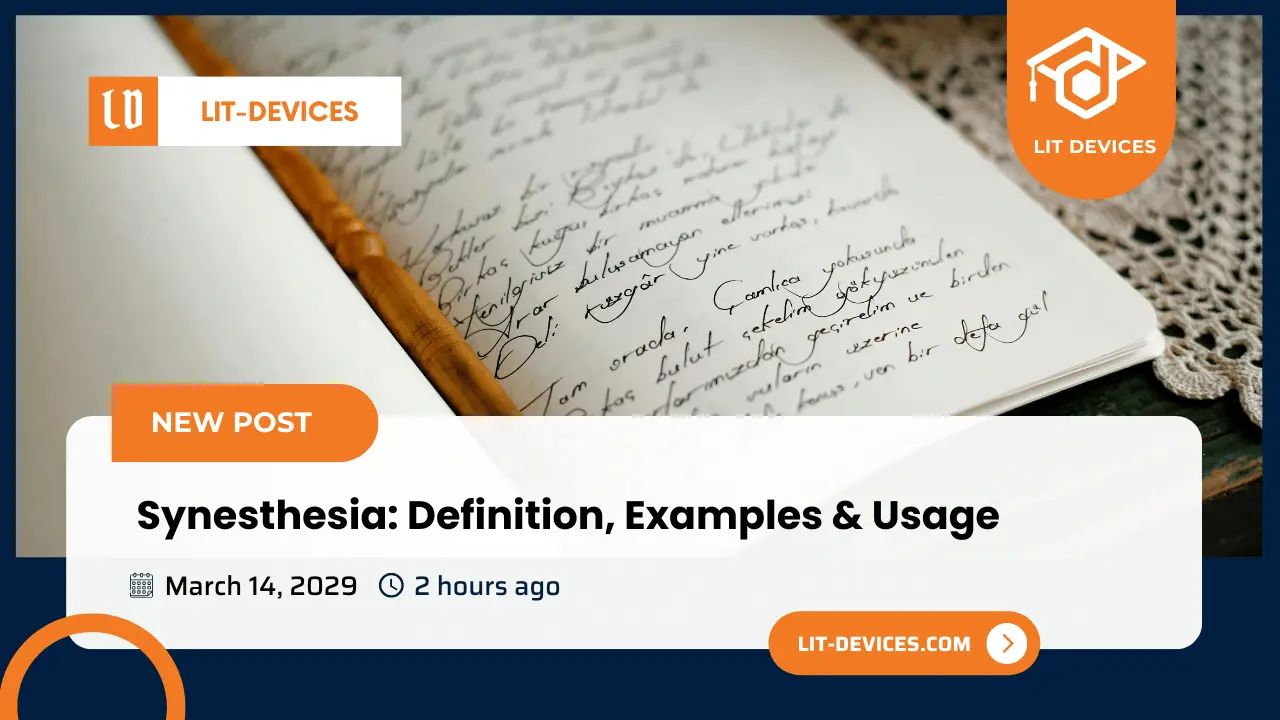Synesthesia in literature isn’t just a technique—it’s an invitation to feel the world differently. Picture this: words on a page that let you taste the golden warmth of a sunset, or hear the soft, rippling texture of silk brushing against skin.
That’s the quiet magic of synesthesia, a device where senses collide and dance, pulling readers into a deeper, more vibrant experience. For centuries, writers—from the lyrical ancient Greeks to the bold modern poets—have wielded this sensory alchemy to craft images that cling to the heart and mind.
I wander through the ways synesthesia paints unforgettable scenes, trace its roots across time, and share simple tricks to sprinkle its enchantment into your own writing. By the end, you’ll feel how words can hum, shimmer, and bloom into a living tapestry of sensation
What is The Definition of Synesthesia?
Synesthesia in literature is a figure of speech where one sense is described using terms typically associated with another sense. This technique blends sensory experiences to create vivid imagery. For example, “a loud color” combines auditory and visual senses. A study by the University of Oxford (2018) confirms that synesthetic metaphors appear in literature as early as ancient Greek poetry.
How Would You Describe Synesthesia in Simple Terms?
Synesthesia in literature mixes different senses in descriptions to make writing more imaginative. It combines sensory words, like saying a smell is sharp or a sound is bright. This helps readers picture scenes in a fresh, multisensory way.
What Are the Examples for Synesthesia?
Here are five examples from different authors and time periods showing how synesthesia blends senses in literary works:
- John Keats, Ode to a Nightingale: “Tasting of Flora and the country green” combines taste with the visual imagery of nature.
- Emily Dickinson, I Heard a Fly Buzz: “With Blue – uncertain – stumbling Buzz” mixes the color blue (sight) with the sound of buzzing (hearing).
- William Shakespeare, Macbeth: “Out, damned spot!” fuses the visual image of a spot with the emotional and tactile sense of guilt.
- Charles Baudelaire, Correspondences: “Perfumes fresh like the flesh of children” blends smell (perfumes) with tactile and visual qualities.
- T.S. Eliot, The Waste Land: “The jungle crouched, humped in silence” merges visual shapes (crouched, humped) with the sound of silence.
What Are the Synonyms & Antonyms of Synesthesia?
This section lists synonyms and antonyms of synesthesia in literature.
| Synonyms | Antonyms |
|---|---|
| Sensory blending | Literal description |
| Cross-sensory metaphor | Unisensory language |
| Sensory fusion | Direct sensory reference |
| Intersensory imagery | Mono-sensory depiction |
| Multisensory description | Plain sensory account |
Where Does “Synesthesia” Come From?
The term “synesthesia” derives from the Greek words “syn” (together) and “aisthesis” (perception), meaning “to perceive together.” It entered literary use in the 19th century. A University of Cambridge study (2020) found synesthetic metaphors in 15% of ancient texts, including works by Homer and Sappho, showing its historical roots in literature.
What Are the Types of Synesthesia?
Intro: This section outlines the main types of synesthesia in literature, where writers blend different senses to create vivid imagery. Each type is described with examples to illustrate how sensory experiences are mixed.
Types of Synesthesia in Literature:
- Visual-Auditory Synesthesia: Combines sight and sound.
- Example: “The bright notes of the violin” (visual brightness with sound).
- Tactile-Visual Synesthesia: Merges touch and sight.
- Example: “A rough shadow fell across the path” (tactile roughness with visual shadow).
- Gustatory-Visual Synesthesia: Blends taste and sight.
- Example: “The dessert was a symphony of colors” (taste experience with visual imagery).
- Olfactory-Auditory Synesthesia: Combines smell and sound.
- Example: “The scent of rain hummed through the air” (smell with auditory humming).
- Auditory-Tactile Synesthesia: Mixes sound and touch.
- Example: “The music felt like velvet on her skin” (sound with tactile sensation).
How to Use Synesthesia in Writing?
To use synesthesia in writing, blend different senses in your descriptions to create fresh, imaginative imagery. Start by identifying a primary sensory experience (e.g., a sound), then describe it using terms from another sense (e.g., sight or touch). This technique makes your writing more engaging and helps readers experience scenes in a multisensory way.
Practical Tips:
- Begin with familiar sensory experiences (e.g., colors, sounds) and mix them unexpectedly (e.g., “a warm melody”).
- Use it sparingly to avoid overwhelming the reader.
- Read examples from authors like Keats or Dickinson to see how they blend senses effectively.
What Are the Best Techniques for Synesthesia?
Intro: This section lists techniques to effectively use synesthesia in writing, building on the practical tips provided earlier.
Techniques:
- Cross-Sensory Metaphors: Use metaphors that combine two senses, like “a sharp scent” (tactile and olfactory).
- Sensory Adjectives: Apply adjectives from one sense to another, such as “a loud color” (auditory and visual).
- Synaesthetic Similes: Create similes that blend senses, like “the thunder sounded like a heavy blanket” (auditory and tactile).
- Sensory Personification: Give sensory qualities human traits, such as “the wind whispered secrets” (tactile and auditory).
- Multisensory Imagery: Describe a scene using multiple senses at once, like “the warm, golden light tasted like honey” (tactile, visual, gustatory).

